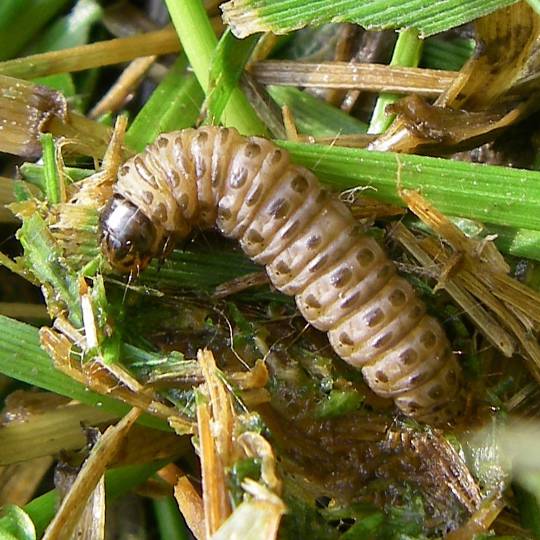
Unlike many invasive pests, sod webworms (crambus) are native to the United States and have a lifespan of about one year. Known for being a nuisance on home lawns, they also plague golf course greens, cemeteries, and other areas commonly exposed to sunlight.
Named for the web-lined tunnels in which they hide during the day, sod webworms are light green to light brown in color, their bodies lined with rows of spots. Adult moths are white or tan with snout-like projections coming out of their heads and wings that wrap around their bodies.
Several species of moths in their second stage of life (the larval stage) are described as sod webworms. The females in most of these species can lay up to 200 eggs in the early summer, but some varieties have been known to lay eggs earlier in the year. Sod webworm larvae emerge from their eggs and begin to feed after about 10 days. They consume leaves and grass stems as they grow, completing a series of approximately six to 10 larval instars. These sod webworm larvae feed through late September. Then, they overwinter and emerge as mature larvae, feeding once more and then pupating from May until early June. The adult moth then emerges after 10 to 14 days. The adult form of this insect is harmless, but larval populations can potentially pose real distress to a lawn. Species that hatch in the early spring have proven to cause the most damage, as they have more time to multiply and consume a lawn in a single season.
Sod Webworm Signs and Symptoms
Small brown spots slowly begin to appear on grass infested by sod webworms, but as the climate gets warmer and drier, the spots rapidly begin to grow and intersect.
Often mistaken for drought stress, webworm-related patches actually do cause the most damage during a drought. Decipher the cause of your lawn damage by getting on your hands and knees and closely inspecting an area of your lawn for the larvae’s distinctive web-lined tunnels. Or, you can move grass blades on the perimeter of a damaged patch and look for excrement pellets left as evidence of webworms.
Sod Webworm Prevention
When the insects are still small and vulnerable, they can easily be killed with insecticides. Apply insecticide to your infested lawn in the early evening as this is the time when larvae are most active.
Nematodes are a non-chemical alternative. Designed to suppress sod webworm populations, these tiny worms live in the soil and kill webworms. Be sure to handle nematodes with care, as they are live organisms.
Sowing endophyte-enhanced turfgrass as new seedlings or incorporating it into your current lawn is another non-chemical option. Endophytes are fungi that can help strengthen grass plants. They also help grass become more resistant to insects and disease.
The proper watering of a lawn can make your grass healthier, which ultimately helps deter webworms.
Contact Cardinal Lawns to discuss control techniques for eradicating sod webworm infestations and keeping your lawn healthy and beautiful.
Need Help with Sod Webworms?
Call Cardinal Lawns today at 614-808-4446 and let's talk about how we can help treat for Sod Webworms and other common Ohio lawn pests.
Get a Free Quote